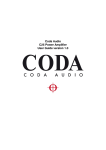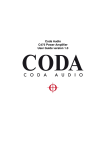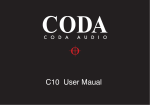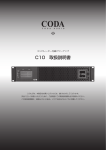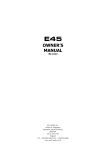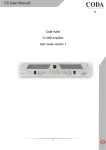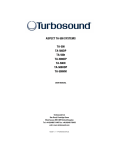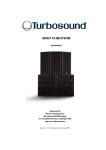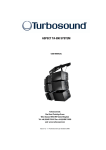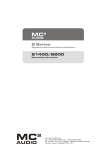Download Coda C45 User guide
Transcript
Coda Audio C45 Power Amplifier User Guide version 1.0 Contents EC Declaration of Conformity Important Safety Instructions Installation Instructions Electrical Mechanical EMC (RF Emissions) General Information 3 4 4 4 5 5 5 -3 dB Indicators Power Reduction Circuit (PRC) 6 6 Level controls Signal indicators -3 dB indicator Limiters PRC indicators Temperature control Fault indicator Bridged LED 8 8 8 8 8 8 8 8 Notes on Dynamic Amplifiers Connections Inputs Outputs Bridged Operation Link Socket Operation Switching on Panel Controls and Indicators Maintenance Gain/Sensitivity settings Air Filter Technical Specification Power requirements Appendix Table of PRC settings and resulting 2 6 6 6 7 7 7 8 8 8 9 9 9 10 10 11 11 C45 User Guide Version 1.0 C45 User Guide Version 1.0 3 Important Safety Instructions 1) Read these instructions. 2) Keep these instructions. 3) Heed all warnings. 4) Follow all instructions. 5) Do not block any ventilation openings, install in accordance with the manufacturer’s instructions. 6) Unplug this apparatus during lightning storms or when unused for long periods of time. 7) Clean only with a dry cloth. 8) Do not use this apparatus near water; the apparatus shall not be exposed to dripping or splashing and no objects filled with liquids, such as vases shall be placed on the apparatus. 9) Refer all servicing to qualified service personnel. Servicing is required when the apparatus has been damaged in any way, such as if the power-supply cord or plug is damaged, liquid has been spilled or objects have fallen into the apparatus, the apparatus has been exposed to rain or moisture, does not operate normally, or has been dropped. Installation Instructions Electrical The amplifier has been manufactured to comply with your local power supply requirements, but before connecting the unit to the supply, ensure that the voltage (printed on the rear panel) is correct. Make sure power outlets conform to the power requirements listed on the back of the unit. Damage caused by connecting to improper AC voltage is not covered by the warranty. Safety Warning Where a mains plug or appliance coupler is used as the disconnect device, it should remain readily operable. Where the amplifier is mounted in a rack and permanently connected to the mains, then the rack should be installed with a readily accessible connector or an all pole circuit breaker. This unit is fitted with a 3-wire power cord. For safety reasons, the earth lead should not be disconnected in any circumstance. If ground loops are encountered consult the section on ‘Input Connections’ later in this manual. The wiring colours are: 230 V Areas: 4 Earth = Green and yellow Neutral = Blue Live = Brown 120 V Areas: Earth = Green Neutral = White Live = Black C45 User Guide Version 1.0 Warning: To reduce the risk of fire or electric shock, do not expose this apparatus to rain or moisture. To avoid electrical shock do not remove covers. Refer all servicing to qualified personnel. Do not use this unit if the electrical power cord is frayed or broken. The power supply cords should be routed so that they are not likely to be walked on or pinched by items placed upon or against them, paying particular attention to cords and plugs and the point where they exit from the appliance. Always operate the unit with the AC ground wire connected to the electrical system ground. Precautions should be taken so that the means of grounding of a piece of equipment is not defeated. Do not remove the lid. Removing the lid will expose you to potentially dangerous voltages. There are no user serviceable parts inside. Mechanical To ensure that this equipment performs to specification, it should be mounted in a suitable rack or enclosure as described below. Like all high power amplifiers, it should be kept away from other equipment which is sensitive to magnetic fields. Also, this amplifier may suffer a substantial reduction in performance if it is subjected to, or mounted close to equipment which radiates high RF fields. When mounting the amplifier in a rack or enclosure, ensure that: 1. The rear of the unit is adequately supported. The brackets which are supplied fit standard 19 inch (483mm) rack mounting systems. The front panel is not capable of supporting the front panel is not capable of supporting the unit on its own. 2. There is adequate ventilation. The cooling fans suck cool air in through the front and blow hot air out at the rear of the unit through the ventilating grills. If the air is not allowed to escape, overheating will occur. Take care when mounting other equipment in the same rack. 3. The rack unit has a separate earth connection (technical earth). Also see maintenance section page 9. EMC (RF Emissions) The high frequency resonant converters in the C Series amplifiers have been designed to have very low radio frequency (RF) emissions, which can cause interference with other equipment. In order for this to be optimised, the amplifier should be mounted in a metal rack enclosure, which should have a separate (technical) Earth. Alternatively a separate earth should be attached to the amplifier at the rear rack mounting bracket. General Information Your C45 power amplifier utilises a proprietary designed progressive switching rail output, which enables the extremely high voltage swings and peak power without compromising the sonic quality. Fan speed is varied as required to keep the amplifier within its temperature limits. Signal limiters are included to protect speakers from clipped signals. The amplifiers include full DC and short circuit protection to ensure trouble-free service even in ‘harsher’ environments. C45 User Guide Version 1.0 5 The C-Series introduces three user-controlled features previously not seen on Coda Audio amplifiers: -3 dB indicators Power reduction control (PRC) User-settable gain/sensitivity (internal) The latest version now also has improved signal level indication with 3 green LEDs in a ‘bar chart’ format. This gives a much clearer indication of level to the operator. The -3 dB and Limit LEDs continue the bar format. -3 dB Indicators Part of the front panel signal level display, they will light up when the signal is approximately 3 dB below the limiting point. The limiting point is set during production to be at the onset of clipping. The response times of the -3 dB indicators (YELLOW) are faster than those of the limit indicators (ORANGE). Power Reduction Circuit (PRC) This enables the user to set a maximum output power level below the rated output of the amplifier. This reduction is controlled by switches on the rear panel, 2 per channel. Each channel has an LED indicator (GREEN) active when either PRC switch is selected. A full table of PRC settings and the resulting outputs are given in the Appendix. The possible settings are: -2 dB, -4 dB, -6 dB. This relates to the maximum output of the amplifier. (See the chart in the Appendix section at the end of this manual.) In bridged mode the Channel A PRC circuit operates over both Channel A and B. In this mode Channel B PRC is not used and is out of circuit. Notes on Dynamic Amplifiers The C45 is the very latest example of a ‘dynamic amplifier’. This new ‘breed’ of power amplifiers provide very high peak power levels in a much smaller, and lighter, package than previously possible with conventional amplifiers. They are designed specifically for today’s high power audio installations, which use multiple speakers with electronic crossovers or speaker controllers. These systems can handle very high transient signals which far exceed their RMS power rating. The C-Series amplifiers have been designed to match this requirement and can deliver huge levels of power for short durations (just under a second). In order to protect themselves and the loudspeakers that they are driving, continuous signals, such as sine waves, are automatically detected and reduced (ramped down) to a safe level. When trying to measure the power output however, continuous signals will give totally incorrect results. A dynamic signal, such as a tone burst, should be used and the levels measured by monitoring the waveform on an oscilloscope. The power envelope can then be accurately measured. Connections Inputs The inputs are made via 3-pin XLR connectors, which are electronically balanced and should be connected via a high grade twin core screened cable, as follows: PIN1 PIN2 PIN3 6 - Screen (see note) - Hot (signal +) - Cold (signal -) C45 User Guide Version 1.0 The amplifier is designed to operate with fully balanced equipment and ground loops or loss of performance may be experienced if connected to unbalanced sources. If it is unavoidable however, the following wiring should be used. The cable should still be twin core plus screen. PIN1 - Screen - connected to the chassis of the unbalanced equipment - or left disconnected at the unbalanced end. PIN2 - Signal Hot PIN3 - Signal Cold Note: This amplifier is wired to the latest industry recommendations. PIN1 is connected directly to the chassis/mains earth. If ground loops (mains hum) are encountered remove the screen connection from the other end of the cable and leave it open circuit. If problems persist, consult your dealer/supplier. Do not tamper with or alter any ground (earth) connections inside the amplifier. For bridged operation input should be made to channel A only and the rear panel switch set for bridged mode. Outputs Channel A and Channel B speaker outputs are via Neutrik Speakon connectors. Only 2 of the 4 poles are used. 2-pole (NL2FC) or 4-pole (NL4FC) connectors can be used. Terminations are as follows: Note: Pin + 1 = +ve Pin - 1 = -ve 1. Negative (-ve) output terminals must not be joined together, since they are not both at 0V. 2. Because the currents involved are very high, the speaker cables should conform to the following minimum requirements, otherwise the losses will cause the cables to get hot and audio power will be reduced: C45 - 20 A into 4 Ohm speaker loads. Bridged (Mono) Mode Use centre Speakon connector marked ‘BRIDGED’ and connect as follows: For bridged operation: Pin 1- = Pin 2+ = -ve (Ch A) +ve (Ch B) For 4-pole connection to both channels: (Bridged switch de-selected [ie Out]) Pin 1+ Pin 1Pin 2+ Pin 2- Ch. A +ve Ch. A -ve Ch. B +ve Ch. B –ve = = = = When operating in bridged mode, the minimum impedances are doubled. The minimum load in bridged mode is 4 Ohm. Link Socket Each channel is provided with a 3-pin XLR connector marked ‘LINK’ which allows the input signal to be linked to further amplifiers etc. The connections are the same as for the input XLR. C45 User Guide Version 1.0 7 Operation Switching on At ‘switch-on’ the protection circuit will initially activate whilst the circuits stabilise. Assuming no faults are detected after a few seconds, only the ‘POWER’ LED (and ‘SIGNAL’ indicators if signal is applied) will illuminate. Panel controls and indicators Level controls These are analogue controls allowing precise level settings. Note that in ‘BRIDGED’ mode only ‘channel A’ control is active. Signal Indicators (3 Green LEDs) These are active from a minimum output level of approximately 10 Watts and are only an indication of signal level. -3dB Indicators (yellow LED) These are active when the signal is 3dB below the limiting level. Limiters (Red LED) The C-Series amplifiers incorporate signal limiters, which are preset to prevent clipping with high levels of drive. The amber LEDs on the front panel illuminate to indicate operation of the limiters. PRC Indicators (green LED) These indicate when the PRC circuit for that specific channel has been selected with the rear panel switches. Temperature Control The cooling fans respond to temperature sensors within the unit to maintain a safe operating temperature. In the event of excessive temperature, the protection circuit will operate, disabling the output. The red ‘AUDIO-PROTECT’ (A/P) LED will indicate this condition. (See fault indicator.) There are 4 fans connected permanently with variable speed and a jumper link to enable them from cold. Normal dynamic signals will not cause the amplifier to overheat unless the ventilation is inadequate. (See installation section and maintenance section.) Fault Indicator (Audio Protection – red LED) If the outputs are shorted or if DC is present, the protection circuit will disengage the outputs and the A/P LED will illuminate. The amplifier will continue to be monitored and depending on the type of fault, will either reset after the fault has cleared or require manual resetting by switching off at the mains switch and then on again after a few seconds. (See also temperature control above.) Temperature related faults will reset once the unit has cooled sufficiently. Output short circuits will require manual reset after clearing the fault. Bridged LED (green) This indicates the position of the switch on the rear panel and is illuminated when bridged mode is selected with the switch pressed in. 8 C45 User Guide Version 1.0 Maintenance Caution: These servicing instructions are for use by qualified personnel only. Ensure that Electrical power to the unit is disconnected before carrying out any maintenance. Gain/Sensitivity settings Gain settings are changed internally by simple jumper links. Two rows of pins marked - GAIN A and GAIN B - are situated on the input PCB (PCB701). A jumper link sets the gain and the settings are as follows: Link 1 & 2 Link 3 & 4 Link 2 & 3 Note: gives gives gives 32 dB gain 26 dB gain approx. 35.75 dB gain = 6 dBu/1.5 V sensitivity C45 Factory setting is normally link 1 & 2 = 32 dB gain. Setting higher gain does not change the maximum available power but changes the level of signal input to achieve maximum power. In any case, provided that the input signal is less than 20 dBu/7.7 V, the built in limiter circuit will prevent distortion within the amplifier. The gain should be set to match the signal from the source, e.g. mixer, controller, equaliser etc. Air Filter The filter behind the air intake apertures on the front of C-Series amplifiers should be cleaned or replaced periodically, e.g. 3-6 months. (Filters in amplifiers located in more 'dirty' atmospheres may require more frequent maintenance). Access is via the blue front panel retained by 2.5 mm Hex screws. The filter should be 'dry' cleaned, using a vacuum cleaner preferably. Running the unit without a filter is not recommended unless it is within a 'clean room'. Replacement filter material is available. No other regular maintenance is required. If you have any doubt about carrying out this procedure, refer to a service engineer or contact your dealer. If your amplifier develops a fault, please refer to your supplier for service and technical support. Do not attempt to repair the fault yourself as this will invalidate the warranty. C45 User Guide Version 1.0 9 Technical Specification Output power (Watts RMS) per channel 8 Ohm @ 1 kHz 4 Ohm @ 1 kHz 2 Ohm @ 1 kHz 1200 2250 3200 Mono Bridged 8 Ohm @ 1 kHz 4 Ohm @ 1 kHz 4400 6400 THD @ rated power 4 Ohm 1 kHz 20 Hz-20 kHz <0.009 % <0.03 % Input CMRR >90 dB Hum & Noise -105 dB Gain (selectable) +32 dB/+26 dB/+35.7 dB Sensitivity for rated output, 4 Ohm +9.75 dBu/+15.75 dBu/+6 dBu (1.5 V) Damping Factor 1 kHz, 8 ohms >400 Frequency response 20 Hz-20 kHz - +0/-0.5 dB Input impedance (actively balanced) 20 kOhm Dimensions (mm) -2U 88 x 482 x 428 Weight 11kgs Power requirement 230 VAC @ 20 amps max 115 VAC @ 40 amps max Power requirements The C45 can be supplied for nominal mains voltage of 115 V or 230 V. An internal link can be set to either 100 V or 120 V for the 115 V version and 220 V or 240 V for the 230 V version. Normally these are set to 120 V and 240 V respectively. This amplifier will only operate to its very high specification if it is installed and operated as described in this manual. 10 C45 User Guide Version 1.0 Appendix Table of PRC settings and resulting Output Output Per Channel (Watts) Bridged Mode (Watts) Max Power into 4 Ohm -2 dBu PRC Setting -4 dBu PRC Setting -6 dBu PRC Setting 2250 1400 900 560 6400 4000 2500 1600 Max Power into 8 Ohm -2 dBu PRC Setting -4 dBu PRC Setting -6 dBu PRC Setting 1200 800 525 350 4400 2800 1800 1200 Max Power into 2 Ohm -2 dBu PRC Setting -4 dBu PRC Setting -6 dBu PRC Setting 3200 2000 1250 800 N/A N/A N/A N/A C45 User Guide Version 1.0 11 Coda Audio GmbH Boulvard der EU 6 30539 Hannover Germany Phone: +49 (0) 511 – 866 55 888 Fax: +49 (0) 511 – 866 55 887 E-Mail: [email protected] Website: www.codaaudio.com












